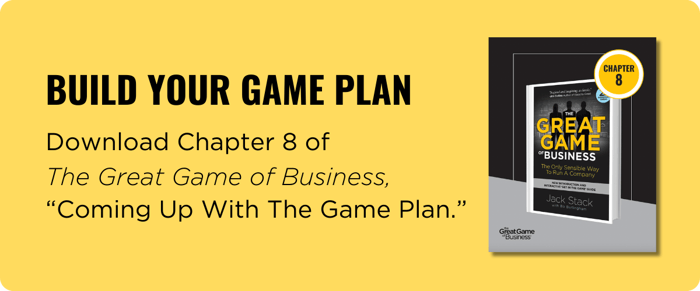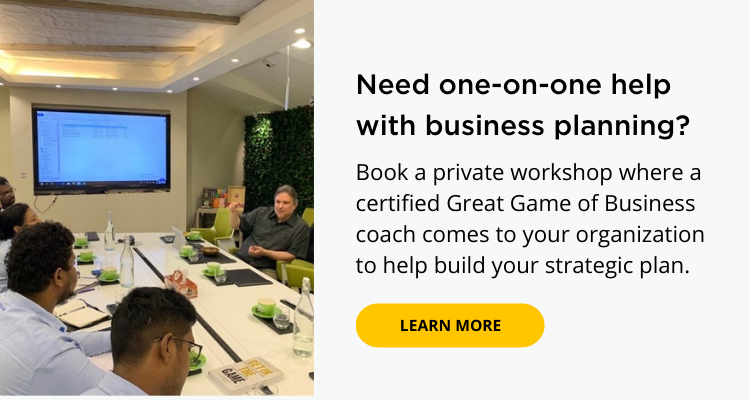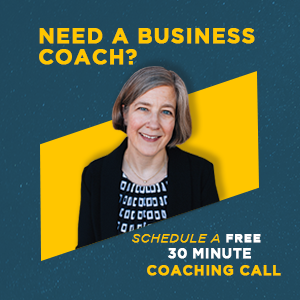
For nearly four decades, SRC has been perfecting its approach to strategic planning, and every year it keeps getting better. Here’s the proven step-by-step approach to building good, accurate plans employees love to execute.
People Support what they help to create. That is why at SRC and The Great Game of Business®, building a strategic plan is about involving ALL employees in the planning process. That means planning is a year-round event, and it begins with what’s happening in the real world. Twice a year, in June and October, SRC brings the marketplace to its people so they can accomplish two goals:
-
Develop business-growth plans they can own.
-
Help employees answer the questions: Are we confident and energized about the direction of the company?
Having a strategic plan is more than putting on paper what you plan on doing over the next year. It is about setting a strategy, building a plan, dealing with market changes, and most importantly, enabling everybody to contribute. This is what we at The Great Game of Business call High-Involvement Planning™.
Big picture — High-Involvement Planning can be broke down into clarifying your strategy and building your plan. If you zoom in, you will see that there are really ten steps to having a successful strategic plan.
1. Share your winning aspirations.
The next-gen workforce wants to be part of something bigger than themselves. They need the why behind the how - maybe more than any other workforce in history.
And with the war for talent raging across the world, you need to get this part right. We can’t stress enough not to underestimate the importance of sharing your winning aspirations. This is not the soft stuff. It’s, in fact, the hard stuff.
Sharing your winning aspiration is foundational to building a great strategy. Your winning aspiration will set the context and inspiration for all that follows. As Jack Stack, the father of open-book management, says, “When you show people the Big Picture, you define winning.”
2. Review your strategy.
Everybody has a strategy. The question … is it the right one?
Is it one that:
- is going to get you to where you want to go?
- provides a sustainable competitive advantage and superior value?
- everyone understands, believes in, and is committed to achieving?
To have a viable strategy for growth, you must dive into the right actions to ensure your success. You start by understanding the drivers that will more than likely impact your industry. Then make a plan on how you will compete and, most importantly, how you will make money. Your strategy must also take into account your target customer, how you will position yourself in the market and deliver your product or service in a way that makes you different from your competitors. All this will give you permission to say “Yes” to winning strategies and say “No” to the strategies that do not fit this scenario.
3. Identify your growth & contingencies
For decades, growth and contingency planning have been at the forefront of SRC’s success. It is a proactive way to ensure short- and long-term success by answering the what-ifs in your business:
- What if … our assumptions are incorrect?
- What if … our largest customer goes out of business?
- What if … our competitors actively pursue our accounts?
- What if … our business gets hit with another Black Swan, like COVID-19?
- What if?… What if?… What if?…
Our definition of contingency is a product or service that has already been researched, developed, and cost-justified and can be activated on very short notice. It’s a vital part of your sales planning process.
Keep in mind that contingency planning is not limited to designing new products and services. It may be that some level of growth can be achieved through suitable acquisitions, expanding a current service, etc. We generally recommend that product and service innovation contingencies are greater than or equal to 15% of your overall sales plan.
The important part is to have the groundwork in place to activate quickly.
4. Know your marketplace.
A business that doesn’t know its market is a business that is destined to fail. If you don’t have a deep understanding of where you play and who you are competing against, how can you expect to win? Having a market-driven company that combines a customer focus, together with an awareness of competitors and a deep understanding of the market, will put you at an advantage over your competition.

At SRC, we analyze our rivals much like an investor analyzes a critical investment. They compare them with stats related to profitability, labor efficiency, quality, debt burden, liquidity, customer reputation, and overall image in the marketplace. “Think of a SWOT analysis on steroids,” offers Great Game’s Vice President, Steve Baker. “We need to know who could take us out.” They also examine customer data, the product/service mix, and new business opportunities to measure organizational diversity, fitness, and security.
5. Establish your strategic priorities.
Strategic priorities represent the long-term and short-term key strategic choices that give you the best opportunity to win. Your strategic priorities should create:
- a sustainable competitive advantage.
- superior financial returns.
- superior value.
We use an OSGM model (Objectives, Goals, Strategies, and Measure) to establish strategic priorities. The beauty and versatility of the OGSM model is how easy it is to implement. The most crucial part for success in creating an OGSM plan is making sure that you carefully and accurately define your terms: objective, goals, strategies, and measures. Overall, all model stages need to be strategically aligned, so your efforts feedback to your overall objectives for success.
6. Build your sales plan.
We start with the sales plan because it’s the first line on the income statement. Your sales plan should be believable and predictable with the goal of team alignment and buy-in. By educating, informing, and involving the team in what we know about the marketplace, how we plan to win, and how we are performing, we can all align on one singular goal, the Critical Number™.
A fully developed sales and marketing plan is market-driven, performance-based, performance-focused, and fully supported.
- Market Driven: Any stated goal must be based on true market potential, not some arbitrary “pie-in-the-sky” number. The data and information gathered from a market analysis are vital to developing a believable, predictable sales plan for this year’s annual (short-term) and long-term plans.
- Performance-based: Looking at five years’ worth of historical sales data provides valuable insight into trends and cycles that may affect our sales and marketing strategy moving forward.
- Performance-focused: The sales and marketing strategy should support achieving your Strategy for Growth, short-term (annual plan) and long-term (5-year plan). Again, growth and contingency planning helps the team in achieving planned performance by having an answer ready to any “what if” that might occur.
- Fully Supported: Does the rest of the company support the sales plan? Getting everyone’s buy-in allows the company to harness the business’s potential: human capital, intellectual capital, and financial capital.
7. Ensure confidence in the plan.
Once the plan has been built, your goal is to now secure buy-in. Remember, people support what they help to create. As Jack Stack says, “The way you produce the plan is just as important as the plan itself ... To get ownership and ensure results, you must focus on how your plans are created and how people are involved in the process.” We have seen it over and over. If people don’t participate, they don’t buy-in. If they don’t buy in, they don’t commit. If they don’t commit, they don’t deliver. Shifting the mindset from “what’s your plan” to “this is our plan.”
Don’t wait until step 10 to get your employees involved.
- Present your plan.
- Survey their confidence in the plan.
- Report back on the progress regularly at staff meetings (aka Huddles).
8. Build your financial plan.
The objective of your financial plan is to create an executable program that supports the strategy and sales plan and meets the financial performance objectives. Line item ownership is at the heart of The Great Game of Business. Each line ties to supporting the sales plan. Keep in mind the goal of your financial plan is a line of sight to:
- Strategy: Does the plan allocate resources to support the Competitive Anchors and Strategic Priorities?
- Sales Plan: Do the costs, expenses, and investments support the plan?
- Growth & Contingencies: Does the pipeline support the revenue requirements
9. Build your people plan.
The war for talent has been waging since before COVID-19 hit the globe, but COVID-19 added fuel to the fire. Without the people to execute the marketing plan, sales plan, or financial plan, you will be dead in the water.
You have to identify the WHO when you are building out your strategic plan. This includes planning the workforce size, structure, and skills needed to support the one and five-year plans. Start by defining your current workforce state, define your future state, look for gaps and finally build plans to attract, develop, and creating the workforce over the long term.
10. Execute with The Game
It all comes full circle. Execute, execute, execute. Strategic planning is not always simple, but it is easy to execute and maintain when sharing the load across your entire workforce. We will leave you with the reminder that people support what they help to create, so let them help you create the plan, then execution becomes exciting for those involved instead of a job they were told to do.
Are you interested in learning more about High-Involvement Planning? The best way is to sign up for a free 30-minute call with one of our industry-specific certified coaches.

.png)








.png)




-5.png)

